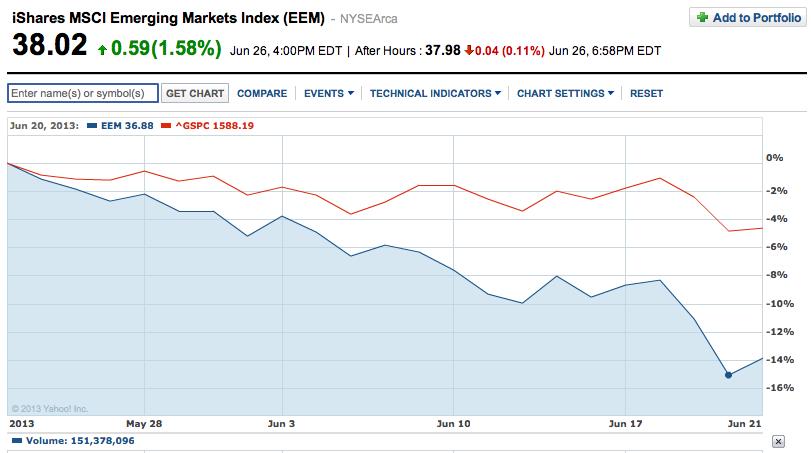In “Failure to Communicate”, we detailed the deleterious impact that the words of Ben Bernanke (U.S. Federal Reserve Chair) words on May 22nd and June 21st have had on the investment markets. In former years (1930’s and prior), when a U.S. official “spoke”, any resulting impact was largely restricted to U.S. markets. However, within the globally inter-connected world of 2013 (especially with the major developed nations engaged in hyperactive monetary accommodation (low interest rates and mega doses of central bank liquidity) whenever “Ben speaks” [to shamelessly steal from an old E.F. Hutton commercial). If we thought that a loss of almost 5% in one month was scary on the S&P 500, and moving from 1.61% yield on the U.S. Treasury 10-year Note to a 22 month high in the vicinity of one percent higher was mind-boggling, just take a look at what occurred in some emerging markets! (The graph below contrasts the S&P’s (red) one-month slide with the -14% shellacking suffered by the iShare MSCI Emerging Markets Index (EEM) (blue).
Things were worse in Turkey and Brazil [The graph below contrasts EEM’s atrocious one-month price movement with the abysmal price moves for iShares MSCI Turkey Invest Market Index (TUR) in green and iShares Brazil Capped Index (EWZ)(brown). Obviously, emerging markets have had a bad month.
However, the cold hard truth is that emerging markets have gone through an extremely harsh “year-to-date” (YTD) period so far in 2013: [this graph contrasts the S&P 500 (red) with the EEM market action in blue]:
Looking at the numbers, the EEM started the year at $45.22. By June 20, it had dropped to $36.65, a drop of almost 19% YTD. Suggesting how volatile the stock can be, during the week ended June 22nd, the following offers you the intraday ranges:
June 19 High-Close -2.8%
June 20 High-Low -3.0%
June 21 Low-High +2.2%
Those are great ranges of day traders (who “get it right”) but not for anyone “faint of heart”! It is also significant to note that, in June’s second week, $2.72 billion of assets were pulled out of the fund!
From a “technical analysis” perspective, it was widely noted that EEM experienced a “Death Cross” in early June (6/7). That is the name given to any crossing of the 50-day moving average below the 200-day moving average. However, despite its ominous name, the “Death Cross” has a spotty record as an indicator of future price moves. During the past ten years, the EEM has moved through seven “Death Crosses” – but only two of them led to a lower stock price two months later. In those two instances, the price two months later was down over 15%.
Why am I dwelling on the Emerging Market space, and why are these negative returns in 2013 significant? Let me approach this from two perspectives: 1) the “simple” and 2) the “more complex”. [Note that from now on, I use the abbreviation “EM” to stand for “Emerging Markets”]
SIMPLE: the performance within the EM space has defied almost every “fundamental analysis” I have seen. During the past twelve months, the so-called “experts” have largely agreed that everyone should have an allocation within the EM asset class. Why have so many suggested this? Here is a cursory list of the reasons (not an exhaustive list):
1) Much improved financial stability. For example (per JP Morgan research) as recently as 2003, only 35% of EM fixed income securities were rated “investment grade”, while by the end of 2012, credit quality had so vastly improved that 65% of said securities qualified as investment grade.
2) The economies and consumers within EM nations are a burgeoning force within world. Whether looked at from geography or population, EM areas compose approximately 80% of the world.
3) More significantly, EM economies once accounted for a “small sliver” of global GDP. Now however(per one EM expert [1]), EM economies generate about 40% of global GDP!
4) To the left is a graph of this same metric prepared by the International Monetary Fund (IMF). Note that the IMF has a much lower figure for EM “GDP percent of world GDP” (EM line is in brown) than Carlson; however, I offer the graph primarily so you can visualize the slope of the growth line!
5) Within a number of EM nations, economies are undergoing a transformative shift from heavily “export-driven” to a more sustainable blend of exports supplemented by a growing “consumer economy”.
6) Finally, the economies with the EM nations have been the primary “growth engine” for the world recently. Here is another IMF graph, showing relative growth. [EM GDP is the brown line]
Since equity securities within the EM space have done horribly, one might hope that fixed income securities would have performed well (since bonds often offer a nice “cushion” when stocks tumble). However, EM bonds have been battered in May and June. The largest (by far) EM fixed income ETF is iShares JP Morgan USD Emerging Markets Bond (EMB). Between the May high and the end of June low, EMB suffered nearly a 15% decline! (Bonds are not supposed to fall off a cliff!). On June 5th, $80 million was pulled by investors from EMB, contributing to a YTD asset outflow (resembling a hemorrhage) of $1.23 billion (per IndexUniverse). Not surprisingly, short interest (SI) in EMB surged to 8.5 million shares – quadruple the size of SI at the end of 2012!
Within the EM fixed income markets, there is an apparent paradox (or an irony). The “simple” EM markets story is that, as a whole, EM governments have been much more disciplined with fiscal and monetary policy than the QE-crazy nations within the so-called “developed” world. In theory, that would imply that the Singapore Dollar or Turkish Lira or some other EM currency would be less susceptible to the ravages of devaluation than the Euro, the Dollar, or the Yen. The problem here is the term “in theory”. And that leads us into the realm of the “Complex” to which I referred earlier.
“COMPLEX”:
How I long for the “simpler days of yore”, when it was easier to look at economic data and discern investment trends (at least it seemed so)! Now, in an ever more complex and interconnected global economy, everything seems tied to everything else. For example, the U.S. Dollar’s status as the world’s “safe haven” has resulted in the neutralization of standard economic rules regarding the currency pricing impact of fiscal and monetary policy. What has trumped all else in the EM area, as with other arenas, have been four primary forces:
1) The injection of “Taper” into Federal Reserve lexicon, with all the attendant angst and over-reaction;
2) Various political developments, such as the spread of public protests (Turkey, Brazil);
3) The usually inscrutable and unreliable news (and analyses) regarding China – that ranges between a “gushing” over the importance of its role in the world as a “growth engine” (growth in excess of 7%) and its huge $3 trillion currency reserve… to warnings not to trust anything the government says and alarming news regarding a mega “liquidity squeeze” currently buffeting banking and finance in China.
4) Within the EM fixed income space, no matter how sound fiscal and monetary policy might be, central bank policies in Europe, Japan, China, and the U.S. (all vital trading partners) easily overwhelm EM bonds. Despite the positives I listed at the beginning, the financial markets in EM nations are dwarfed by the size of developed world markets. For example, even “ripples” in the U.S. market can produce “waves” in EM markets, due to relative size and perception of risk. One super simple example is the Brazilian Real. Despite its much sounder economic policies, the “super low interest rates” in the U.S. and Europe caused money to flow powerfully into Brazil, which caused the Real to move up in value, making exports much more expensive, and therefore less competitive. Therefore, it put on currency controls (in self-defense) that caused other complications and dislocations. (I chalk this up to the category of “you just can’t win!”)
Within both the bond and equity EM markets, these forces have combined to bring significant fear into play, and fear brings a crescendo of lower prices.
Therefore, what is an investor to do? The “fundamental case” has not changed. But obviously there are countless other forces at work! With the understanding that I am not offering a recommendation, let me offer two brief observations.
Below is a five-year graph comparing EMB with the SPDR Barclays Aggregate Bond ETF (LAG) – which represents the most commonly used index for the U.S. bond market. Note that since 2009, EMB has (generally) outperformed LAG. If one finds the “fundamental” case for EM debt compelling,
it should be appealing that EMB’s trend line has fallen down to, and a bit beyond, that of LAG. There is no question that, on a valuation basis, EMB is now a better value than in January. If that piques your interest, what strategy might be reasonable?
The first natural place to look is in the option chain. Alas, despite EMB’s massive capitalization (earlier this year it stood at almost $6 billion) and liquidity (almost 1 million shares traded today), the open interest (OI) in the front month is low and spreads are quite wide. Therefore, I believe the only feasible option strategy is to pick a strike price at which you don’t mind owning it and place a short put sell limit order in at the upper range of the spread. An alternative is to place a straight buy order for the ETF at your preferred price. The ETF is volatile enough that it could break downward toward your price for a fill.
Here are some basic data points through to compare EMB with LAG:
EMB LAG
SEC 30 day yield 4.35% 1.7%
Total Assets $5.7 B 689 M
3 Year Beta .90 1.0
It is easy to see that, over time, assuming normal economic conditions, your annual income from EMB would be approximately two and one-half higher than in LAG. However, you must do your own due diligence before buying or selling anything!
On the equity side, below is a five-year graph of EEM versus the S&P 500 Index. Once again, the most glaring visual is two-fold: 1) EEM paralleled the S&P between April of 2009 and September of 2011; 2) Since then, it has cycled higher and lower in a range, bringing it toward the lower end of its range and showing greater relative value than normal.
That does not mean it is a “buy”. However, it can mean that if you are drawn to EM equities, you should begin to scout out your options. Speaking of “options”, in contrast with EMB, the options for EEM are actively traded, with high OI and narrow spreads. The shares have not moved below $35/each since July of 2009. If you look at an August 35 P, and place a limit order, it is likely you could get a fill at $0.50 or higher, for an “effective price” of $34.50 should you be assigned. Let me hasten to add this is not a recommendation, just one option among countless available. Data points of interest include the following:
Yield 1.75% (as of 3/31/13)
Total Assets $45 Billion (as of March)
Ave. Volume 67 Million shares
Beta (3 year) .99
The success of such an investment will hinge on political stability and a stable or growing world economy (especially those of major trading partners, the U.S., China, Japan, Europe). However, from a “relative value” perspective, there is no question that now is a better time to buy EEM than six months ago. Eventually, “fundamentals” should kick in. EEM might even outperform the S&P 500, as it often has in the past.
I feel you thinking: “But, Tom, some EM country equities will outperform others. I’ve heard that Singapore is a promising choice.” In reply, all I can say is that any given single EM country is more risky than the aggregate group of them. For your benefit, I offer the 5-year graph below of EEM versus iShares MSCI Singapore Index ETF (EWS)(red) – which has had periods during which it has outperformed and times it has underperformed. I feel more comfortable with a diversified ETF within the EM asset class.
There you have it. Emerging Markets offer a tremendous fundamental story, but come with the overhang of frequently explosive volatility. As a follow-up, I will soon outline for you details regarding one important characteristic of ETFs that recently led the Financial Times to suggest that some chicanery was afoot within the pricing of EEM on June 21st. I’ll offer you reasons why the Times merely misunderstood foreign ETFs. You’ll want to watch for it!
DISCLOSURE: The author owns options on EEM, and owns shares of CAF and EWH. Nothing contained above is intended as a recommendation to buy or sell anything. Consult with your financial expert before taking any action.
[1] John Carlson, who manages funds in the EM space for Fidelity Investments.
Related Posts
Also on Market Tamer…
Follow Us on Facebook


 Why Shares in Data Center Equipment Company Vertiv Surged This Week
Why Shares in Data Center Equipment Company Vertiv Surged This Week



